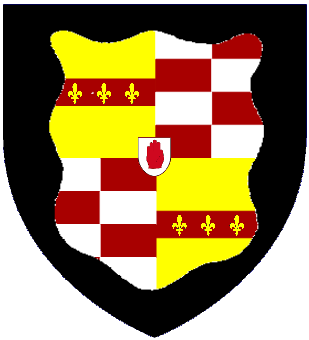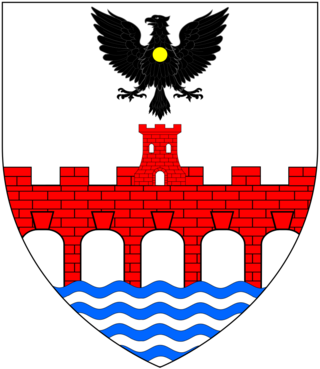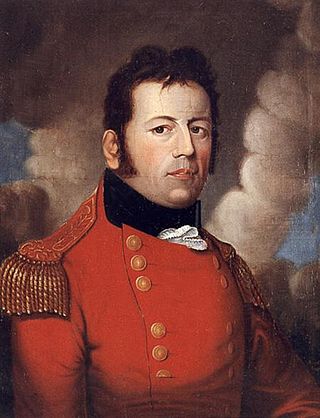
The de Bathe baronetcy of Knightstown, Cashel and Ladyrath in the County of Meath was created on 7 July 1801 for James de Bathe. [1] [2] It became extinct upon the death of the 6th baronet, in 1941.

The de Bathe baronetcy of Knightstown, Cashel and Ladyrath in the County of Meath was created on 7 July 1801 for James de Bathe. [1] [2] It became extinct upon the death of the 6th baronet, in 1941.

Viscount Hardinge, of Lahore and of Kings Newton in the County of Derby, is a title in the Peerage of the United Kingdom. It was created in 1846 for the soldier and Tory politician Sir Henry Hardinge. His son, the second Viscount, represented Downpatrick in Parliament. His great-great-grandson, the sixth Viscount, succeeded a distant relative as eighth Baronet, of Belle Isle in the County of Fermanagh, in 1986. This title had been created in the Baronetage of the United Kingdom 1801 for Richard Hardinge. He was the third son of Nicolas Hardinge, younger brother of Reverend Henry Hardinge and uncle of the latter's third son Henry Hardinge, 1st Viscount Hardinge. The baronetcy was created with special remainder to the heirs male of Richard Hardinge's father.

The Strachey baronetcy, of Sutton Court in the County of Somerset, England, is a title in the Baronetage of the United Kingdom. This family was originally seated at Walden, Essex, where William Strachey was living under the rule of Edward VI. Later they moved to Surrey and at last settled at Sutton Court, Somerset. The title was created on 15 June 1801 for the politician and civil servant Henry Strachey. Sir Henry was private secretary to Lord Clive during his last expedition to India in 1764. He also took part in negotiations for peace with North America where he assisted the kings commissioners at Paris. He died in 1809 and was succeeded by his eldest son Henry, the second Baronet Strachey. His great-grandson, the fourth Baronet, was a Liberal politician. On 3 November 1911, he was created Baron Strachie, of Sutton Court in the County of Somerset, in the Peerage of the United Kingdom. He later served as Paymaster General. The peerage became extinct on the death of his son, the second Baron, in 1973. The baronetage is currently dormant.

The Austin Baronetcy, of Red Hill in the parish of Castleford in the West Riding of the County of York, is a title in the Baronetage of the United Kingdom. It was created on 16 July 1894 for John Austin, Liberal member of parliament for Osgoldcross.

The Barrett-Lennard Baronetcy, of Belhus in the County of Essex, is a title in the Baronetage of the United Kingdom. It was created on 30 June 1801 for Thomas Barrett-Lennard, subsequently Member of Parliament for Essex South. He was the illegitimate son and testamentary heir of Thomas Barrett-Lennard, 17th Baron Dacre. He was succeeded by his grandson, the second Baronet, the son of Thomas Barrett-Lennard, Member of Parliament for Maldon. His son, the third Baronet, was childless and was succeeded by his younger brother, the fourth Baronet. This line of the family failed on the death in 1977 of his son, the fifth Baronet, who died without male issue. The late Baronet was succeeded by his third cousin once removed, the sixth Baronet. He was the son of Sir Fiennes Cecil Arthur Barrett-Lennard, Chief Justice of Jamaica, son of Captain Thomas George Barrett-Lennard, son of the first marriage of George Barrett-Lennard, son of John Barrett-Lennard, second son of the first Baronet. The sixth Baronet was a Catholic clergyman. As of 2014 the title is held by his second cousin, the seventh Baronet, who succeeded in 2007. He is the grandson of Trenchard Barrett-Lennard, son of the aforementioned George Lennard-Barrett by his second marriage. As of 31 December 2013 the present Baronet has not successfully proven his succession and is therefore not on the Official Roll of the Baronetage, with the baronetcy considered vacant since 2007.

There have been two baronetcies created for the Guise family, one in the Baronetage of England and one in the Baronetage of Great Britain. The latter creation is extant as of 2014.
There have been four baronetcies created for persons with the surname Bell, all in the Baronetage of the United Kingdom. One creation is extant as of 2007.

The Baynes Baronetcy, of Harefield Place in the County of Middlesex, is a title in the Baronetage of the United Kingdom. It was created on 29 June 1801 for Christopher Baynes. He was Major-Commandant of the Uxbridge Gentlemen and Yeomanry Cavalry, which he helped to raise. The title descended from father to son until the death of his great-great-grandson, the fifth Baronet, in 1971. The late Baronet died unmarried and was succeeded by his first cousin, the sixth Baronet. He was the son of Reverend Malcolm Charles Baynes, fourth son of the third Baronet. As of 2023 the title is held by his grandson, the eighth Baronet, who succeeded his father in 2005.

The Walsham Baronetcy, of Knill Court in the County of Hereford, was a title in the Baronetage of the United Kingdom. It was created on 30 September 1831 for John James Walsham. He received the baronetcy as the eldest co-heir and representative of Sir Thomas Morgan, 1st Baronet. The second Baronet was Envoy Extraordinary and Minister Plenipotentiary to China from 1885 to 1892 and to Romania from 1892 to 1893. The fourth Baronet was a rear admiral in the Royal Navy.

The Synge Baronetcy, of Kiltrough in the County of Meath, is a title in the Baronetage of the United Kingdom. It was created on 12 August 1801 for Robert Synge. The third Baronet served as High Sheriff of County Cork in 1844. The family surname is pronounced "Sing". As of 28 February 2014 the present Baronet has not successfully proven his succession and is therefore not on the Official Roll of the Baronetage, with the baronetcy considered dormant since 2011.
The Goold Baronetcy, of Old Court in the County of Cork, is a title in the Baronetage of the United Kingdom. It was created on 8 August 1801 for Francis Goold, with remainder to the heirs male of his father Henry Michael Goold, who gave valuable service to the government of King George III. The Goold family descends from William Gould, who served as Mayor of Cork during the reign of King Henry VII. His descendant George Gould changed the spelling of the surname to Goold. He was the father of Henry Michael Goold and the grandfather of the first Baronet.

The Keane Baronetcy, of Belmont in the County of Waterford, is a title in the Baronetage of the United Kingdom. It was created on 1 August 1801 for John Keane, Member of Parliament for Youghal from 1801 to 1806 and from 1808 to 1818. He had earlier represented Bangor in the Irish House of Commons. The second Baronet was Whig Member of Parliament for County Waterford between 1832 and 1835. The third Baronet served as high sheriff of County Waterford in 1856 and the fourth Baronet in 1881. The fifth Baronet was a Senator of the Irish Free State and Governor of the Bank of Ireland. The sixth Baronet, Sir Richard Keane, excelled in the military and also worked in 1930s as a diplomatic correspondent for The Times newspaper. Sir Richard Keane was also partly responsible for bringing the Military and Hospitaller Order of St. Lazarus of Jerusalem to Ireland in 1962 and was a Knight of St. Lazarus. As of 2014 the title is held by his son, the seventh Baronet, who succeeded in 2010.

The Lethbridge Baronetcy, of Westaway House in Devon and Winkley Court in the County of Somerset, is a title in the Baronetage of the United Kingdom. It was created on 15 June 1804 for John Lethbridge, who was later Member of Parliament (MP) for Minehead in Somerset, from 1806 to 1807. The second Baronet sat as MP for Somerset between 1806 and 1812 and 1826 and 1830.

The Price, later Rugge-Price Baronetcy, of Spring Grove in Richmond in the County of Surrey, is a title in the Baronetage of the United Kingdom. It was created on 2 February 1804 for Charles Price, Member of Parliament for the City of London from 1802 to 1812 and Lord Mayor of London from 1802 to 1803. The fifth Baronet assumed in 1874 by Royal licence the additional surname of Rugge. As of 28 February 2014 the present Baronet has not successfully proven his succession and is therefore not on the Official Roll of the Baronetage, with the baronetcy considered dormant since 2000.

The Pigot Baronetcy, of Patshull Hall in the County of Stafford, is a title in the Baronetage of Great Britain. It was created on 5 December 1764 for the politician and colonial administrator George Pigot, with remainder to his brothers General Robert Pigot and Admiral Hugh Pigot, and remains extant. On 19 January 1766 Pigot was further honoured when he was raised to the Peerage of Ireland as Baron Pigot, with normal remainder to the heirs male of his body. Lord Pigot was unmarried and on his death in 1777 the barony became extinct. He was succeeded in the baronetcy according to the special remainder by his brother, Robert, the second Baronet. He was a distinguished soldier.

The Smith, later Smith-Marriott Baronetcy, of Sydling St Nicholas in the County of Dorset, is a title in the Baronetage of Great Britain. It was created on 1 June 1774 for John Smith, High Sheriff of Dorset in 1772. The second Baronet married Elizabeth Anne, daughter of Reverend James Marriott. The fourth Baronet assumed by Royal sign-manual the additional surname of Marriott. The fifth Baronet was High Sheriff of Dorset in 1873.
There have been three baronetcies created for personswith the surname Elphinstone, two in the Baronetage of Nova Scotia and one in the Baronetage of the United Kingdom. As of 2008 two of the creations are extant while one is dormant.

The White baronetcy, of Tuxford and Wallingwells in the County of Nottingham, was created in the Baronetage of the United Kingdom on 20 December 1802 for Thomas Woollaston White, with remainder to the heirs male of his father.
The Stewart Baronetcy, of Balgownie in Bearsden in the County of Dumbarton, was created in the Baronetage of the United Kingdom on 16 December 1920 for James Watson Stewart. He was a member of the Glasgow Corporation from 1904 to 1920 and Lord Provost of Glasgow from 1917 to 1920.

The Prevost baronetcy, of Belmont near Southampton in Hampshire, is a title in the Baronetage of the United Kingdom. It was created on 6 December 1805 for the soldier and colonial administrator Lieutenant-General George Prevost. He was Governor General of British North America from 1812 to 1815. After his death in 1816 his widow Lady Prevost declined the offer of a peerage, as she did not consider herself and her family to have sufficient means to support the dignity. Prevost was the son of General Augustine Prevost, himself a distinguished soldier, who had emigrated to England from Geneva, Switzerland.

The Corbet baronetcy, of Moreton Corbet in the County of Shropshire and of Linslade in the County of Buckingham, was created in the Baronetage of the United Kingdom on 3 October 1828 for Andrew Corbet. He was a descendant of Richard Corbet of Shawbury, brother of Sir Vincent Corbet, 1st Baronet of the 1642 creation.